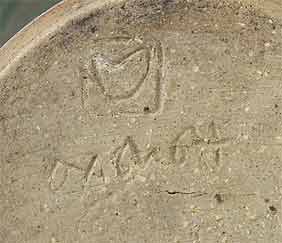
Oxshott tazza (mark)

Oxshott tazza (mark)
See also:
Oxshott tazza (mark)
Wren, Denise
Denise Wren (née Tuckfield) was born in Western Australia in 1891. Her family emigrated to England in 1899, and after a couple of years settled in Surrey. Denise studied at Kingston-upon-Thames School of Art and was taught by Archibald Knox who was an Art Nouveau designer. She learned to throw from a local potter in Surrey and in 1912 bought a kick-wheel from him.
Following her marriage to Henry Wren in 1915, she started evening classes at Camberwell School of Art, and set up her own pottery in Kingston. In 1920 the couple built their own house and workshop at nearby Oxshott, and the Oxshott Pottery was started. Denise's daughter, Rosemary Wren, who became a very respected potter in her own right, was born in 1922 at Oxshott.
Denise worked in earthenware up to the start of the Second World War. She was shown at the British Empire Exhibition of 1923/24, and did much to promote the craft. She wrote books and was busy with teaching commitments. Her first kiln was an American gas-fired Drakenfield, but she designed and built her own coke-fired kilns from the mid-twenties and her designs were used by other potters.
After the war she started making stoneware salt-glazed pots and models. She is particularly well-known for her raku elephants of the 1960s. She was also an accomplished textile designer and was instrumental in the setting up of the Craft Potters Association. She died in 1979.
Oxshott
Oxshott Pottery was started in 1920 at Oxshott in Surrey by Henry and Denise Wren. Their daughter Rosemary Wren was born there in 1922.
The pottery remained at Oxshott until 1978, shortly before Denise's death, and then moved to Exeter in Devon under the direction of Rosemary and her partner, Peter Crotty. Another move followed in 1982, to Newton Abbot, not far away, and then another in 1989 to Strathpeffer in Ross-shire, Scotland.

